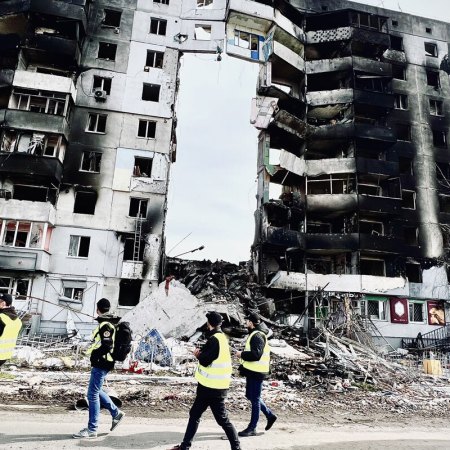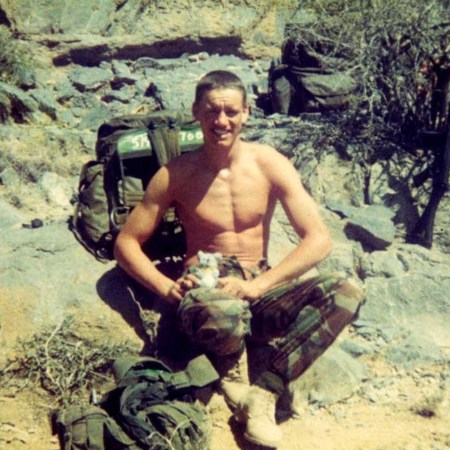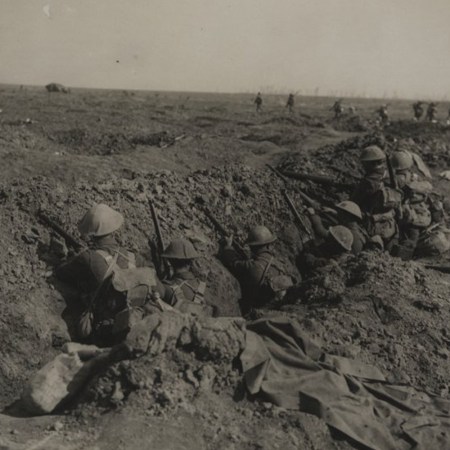War Photographer Gabriele Micalizzi on Close Calls, Embedding With Russians and the Worst Moment of His Life
The celebrated photojournalist, who recently opened his first solo exhibition in Milan, has been on the front lines of conflicts from Gaza to Ukraine

“I remember once I was in Syria driving to the front line with our fixer, this very tough guy, and suddenly he screamed at the driver to stop and for us all to get out,” recalls Gabriele Micalizzi. “Everyone jumped out and ran off into the sand and these bombs went off all around us, filling the car with holes. I just covered my head and kept down. And when I finally looked up, the fixer was just sitting there, smoking a cigar.”
“I seem to find myself in a lot of tragicomic situations like that. But it was a lesson in how to stay cool in a very tense situation.”
Micalizzi — an Italian war photographer, one of the foremost of his generation, who recently opened the first solo exhibition of his work at 29 Arts in Progress Gallery in his native Milan — is no stranger to such events. The 40-year-old may have started out in other visual media, as a street artist and then as a tattooist, but by the time he was 23 he was taking photos covering the U.S.-led invasion of Afghanistan. He caught the bug. Soon after, he covered the Red Shirt riots in Bangkok in 2010, and three years later the ill-fated revolution in Cairo.
Since then, Micalizzi has been documenting conflicts in places like Iraq, Libya, Syria and Gaza. Most recently, he was in Ukraine, where he was the only non-partisan photographer embedded with the Russians in the Donbas. This is a man who vividly recalls the smell of the 30 stacked corpses he had to crawl between in a makeshift morgue in order to get to safety on one occasion.
“It’s the kind of smell you never forget,” he says, matter-of-factly. But the scariest thing about the Donbas? The topography. “Very flat. No cover.”

Such a sanguine perspective is perhaps a consequence of Micalizzi learning, necessarily, to master his fear in his chosen profession. “Fear is with you all the time, mostly just telling you to get away from where you are, and you just have to manage it well,” he explains. “Too much and you lose concentration, which can be fatal. You panic and that’s the most dangerous thing ever. Too little [fear] and you don’t have that incentive to be as aware as you must. But the first thing you must do is accept that you might die.”
He is only half-joking when he says he takes a lesson from the bushido moral code adopted by samurai in Japan: when the samurai finds himself in rain, he doesn’t run faster; nor does he seek shelter; all he can do is accept that he will get wet.

These are not the kinds of thoughts Micalizzi often shares with his family. He has a wife and two teenage daughters who understand his work and his commitment to it but, of course, worry all the time. “I don’t talk with them much when I’m away — doing so makes me feel ‘touchable’ in some way,” he says. “When I’m back, I keep the terrible things quiet. But they see the pictures, they ask questions and I’m honest with them. That’s the way the world is and there’s no point in them thinking otherwise.”
They have to be patient with him whenever he returns from the front lines. It takes, he says, a week or two to readjust to “normal” life. War has taken its more physical toll on him, too. He reckons he’s had three close escapes from death, perhaps the closest being when he was caught in a rocket-propelled grenade attack in Syria in February 2019. That cost him perforated eardrums, most of the sight in one eye, a finger tip and, as he casually puts it, “part of [my] left arm.” His life was only saved by the quick action of one soldier.
He has returned the favor: When, at the Battle of Mosul, a hand grenade explosion “effectively melted” one soldier’s foot, as Micalizzi puts it, he applied a tourniquet using a broken chair leg in a bid to stave off the need for a battlefield amputation — and persuaded the commander to break free of their position in order to get the injured fighter to a surgical outpost. “I think that was the most terrible moment of my life,” he says. “It’s one thing risking your own life, but quite another when you feel responsible for the life of someone else.”


Micalizzi, a Leica Master of Photography award recipient, concedes that while war correspondents should remain dispassionately objective in theory, in practice it’s not so easy. “I do know my duty as a journalist,” he says, “but sometimes on the ground your humanity is more important than journalism. If there’s something I can do to help someone in pain like that, then I will, whether it means I miss the shot or lose the job, so be it.”
The shots, when he gets them, have an artistic quality not often found in those taken in such brutal conditions (his new exhibition is titled “A Kind of Beauty”). Micalizzi admits to a kind of embarrassment in them finding their way into a gallery, to be found beautiful rather than disturbing. “But so much of what I do is instinctive,” he says. “There isn’t the time to direct people, and I’m not very good at that anyway. Things happen and you take pictures of them. That’s all, really. I prefer the imperfections of reality, the fact that it’s often squalid.”

As for the job, it’s one that Micalizzi thinks he can only do for maybe another five years or so. He says that he expects there will come a point when he has to accept that the toll it takes — physically and mentally — will be too much. That’s when you’re more likely to become a burden. “It’s one thing to be a burden on yourself, but in situations of war like that, you really can’t be a burden on other people,” he says. “I’ve had people risk their life for me many times. I wouldn’t want them to do that just because I can’t keep up.”
What will he do then? Micalizzi says he wants to focus on experimental art and documentary photography. “I want to be able to go very slow,” he says. It’s the kind of work that his parents would certainly prefer he pursued. He recalls his mother visiting him in the hospital after that near miss with an RPG and looking him square in the eye.
“She said, ‘It’s time to shoot some fashion now,’” he laughs.



